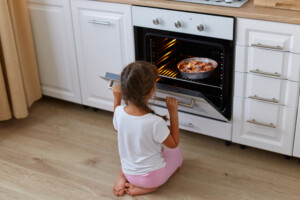When your baby comes home from the hospital, you can feel every emotion, from joy to fear, excitement to concern. You might worry your new baby isn’t sleeping or eating enough. What if the baby spits up too much? Or not at all? Reflux is common in newborns and is usually temporary. Most outgrow it by their first birthday. However, some infants may experience silent reflux, which can bring back that parental anxiety. The good news? Once you know your baby has silent reflux, you can do many things to help.1 I will explain what silent reflux in babies is and its symptoms, but first, let’s discuss reflux.
What Is Reflux?
Reflux happens when the stomach pushes its contents back up into the esophagus. Babies spit up because the muscle at the bottom of the esophagus, called the lower esophageal sphincter, or LES, doesn’t close or opens at the wrong times.1,2
Reflux in Babies
Spitting up is common, and most babies spit up after a meal. Whether they overeat, eat too fast, or swallow too much air, many factors can cause your baby to spit up. For example, if you bounce your baby or sit them up after a meal, the LES will likely open, leading to food coming back up.3
If your baby doesn’t gain weight as fast as your pediatrician would like or has other concerning signs, they may check your little one for gastroesophageal reflux or GER. GER often shows symptoms like:4,5
- Coughs or hiccups when eating
- General irritability
- Irritability during feeding
- Slow weight gain
- Spitting up or vomiting right after eating
- Swallowing or gulping around feeding
Reflux symptoms typically improve as your baby grows and their digestive system matures. However, some infants may experience silent reflux, which can be more challenging to detect.
What Is Silent Reflux?
Silent reflux, unlike typical reflux, doesn’t usually cause spitting up or vomiting. However, silent reflux can still cause many of the same symptoms as its more dramatic cousin. When your baby spits up all over the place after every meal, it doesn’t take much to prompt you to call your healthcare provider.6
But what if your baby seems mostly fine? Sure, they’re a little irritable, and sure, they cough and hiccup when they eat, but those behaviors can sometimes cause fewer concerns than the less-silent symptoms of reflux.
If you notice any reflux symptoms without spit-up, inform your provider immediately. Even without vomiting, your baby could push milk mixed with stomach acid partway up, irritating their esophagus or throat, called laryngopharyngeal reflux (LPR).7
How to Treat Baby’s Silent Reflux
Your pediatrician will examine your baby, assess their symptoms and decide whether further evaluation or treatment is necessary. You can try the following to ease the symptoms and manage your baby’s reflux:1,3,5
Adjust Feedings
Making minor adjustments to how you feel your baby can help reflux enormously. For example, you could try the following:
- Feeding your baby sitting up: Let gravity work for you by pulling that milk away from the esophagus. Try to hold your baby still and upright for 30 minutes after feeding to give the meal a chance to settle.
- Feeding your baby less, more often: Try feeding your baby less formula at a time or a shorter time on the breast. They will want to eat more often, but smaller meals can have an easier time staying down.
- Burping your baby: The more you give the air a chance to work its way out, the less it will push milk up with it. Try to burp your baby more often and see if this makes a difference.
You know your baby best, so try a combination of the above or any ideas of your own!
Sleeping on Their Backs
Babies should also be placed on their backs to sleep. Even though many a grandma may argue that all their babies slept on their tummies, research has proven that babies stay safest on their backs, even if they have reflux.8
Medication
If your baby has trouble with reflux and nothing seems to be working, your healthcare provider may recommend medication for a short time. Reflux medications lower the acid level in the stomach and decrease symptoms of silent reflux.9
When to Call a Provider
Remember, silent reflux is a treatable condition. With the proper treatment, most infants with silent reflux improve and eventually outgrow it. However, if your baby shows any of the following symptoms, inform your provider.10
- Blood in their poop
- Consistent projectile vomiting
- Difficulty breathing
- Lack of energy
- Not enough weight gain
- Refuses to feed
- Spits up blood or anything that looks like coffee grounds.
- Spits up green or yellow liquid.
- Starts spitting up at six months or older.
- Very irritable after eating.
Your provider can look at your little one and plan the best treatment with your input. Before you know it, your baby’s silent reflux may be a distant memory.






























